
By now, you might have heard that DSMN8 co-founder and CEO, Bradley Keenan, has written a book! Employee Advocacy: 101 Cheat Codes is all about how to start and scale your employee advocacy program.
Bradley provides his expert insights from years of experience, condensed into 101 bite-sized chapters, or as he calls them, ‘Cheat Codes’. The idea is that you don’t have to read this book cover-to-cover. You can flip to any page, and discover a valuable employee advocacy insight or strategy.
Today we’re sharing some cheat codes from the book, for those working in sales roles, or looking to improve their social selling strategy.
Employee advocacy is a game-changer for sales teams. According to LinkedIn, 75% of B2B buyers use social media to support purchase decisions. Are your employees actively sharing content?
And research by Edelman revealed that 9/10 of C-suite executives are more receptive to sales or marketing outreach from a company that consistently produces high-quality thought leadership.
Whether you’re currently using social selling software or not, these cheat codes can be implemented.
So let’s jump into some cheat codes for social selling, chosen from each section or ‘level’ of the book 👇
Level 1: Ready, Set, Go!
Use my Ideal Advocates Worksheet to discover the advocates you should onboard to your advocacy program first.

Listen to the podcast episode to find out more about creating personas for your advocates.
#11: Create Personas for Your Potential Advocates to Begin to Understand Them.
In sales, we talk about buying personas. It’s essentially creating a fictional representation of an ideal customer in order to better understand their needs.
So apply that concept to employee advocacy. What are your potential advocates like?
To get you started, I’ve built 4 personas based on the types of people that make good advocates. Understanding their different motivations, challenges, and content preferences before launching will help you shape your program to drive advocate engagement.
1. The Seller
This is the most obvious one, but they aren’t necessarily a salesperson. It’s anyone in the company with quotas to reach. Their main challenge is time. They’re under pressure to hit their numbers. Their motivation to join an advocacy program would be to exceed targets by positioning themselves as thought leaders. The content that resonates with this person helps them make sales. It’ll be things like social proof, case studies, product updates, and industry news.
2. The Leader
The CEO, divisional heads, and sales leaders all have an external responsibility to show what’s going on in the company, and an internal responsibility to lead employees. Their challenge is engaging the workforce. They’re time-poor, and although social media may not be their number one focus, their motivation is to be seen as industry experts while broadcasting company communications, internally and externally. The content that will work for them will be customer success stories, company news (acquisitions, senior leader appointments, mergers), case studies, and financials.
3. The Champion
This is someone who loves where they work. They support the company mission, believe in it, and want to be an ambassador. Their challenge is internal politics. For example, they might not go on LinkedIn and write content about their company, out of fear of stepping on marketing’s toes. They’re afraid of getting it wrong. They also don’t want their employer to think they’re looking for a job by building their personal brand. Their motivation is simple: they enjoy being a cheerleader for the company. The content they lean towards is positive PR, awards, and company culture.
4. The Ambitious
These people are looking to advance their career by networking and building their personal brand. Whether they believe in the company mission or not is irrelevant. They know that sharing content makes them more visible, both internally and externally. It makes them look like a team player and boosts their reputation. This person’s challenge is that they’re dependent on their digital reputation. They need content to share, and lots of it. They don’t have a content preference.
#15: A Strong Personal Brand Is Priceless. Make Sure Employees Know That!
One of the biggest reasons people don’t post on social is that they’re worried it might harm their careers. Employees worry that if they suddenly start posting, their managers and co-workers might think they’re looking for a new job.
To counter those worries, you need to promote the benefits of employees developing strong personal brands—and carry out that promotion at a company level. Encourage all your employees to share, and explain why they should. That way, they’ll feel safe and happy to do so.
You might be worried that helping your employees create their own personal brands could make them more attractive to other companies, potentially resulting in them being headhunted. But actually, employee personal branding will not only hugely benefit your business and its image, but also make it more likely to retain and attract talent.
Employees with strong personal brands have stronger relationships with their social media audiences. This results in those audience members having stronger relationships with your brand. Employees with well-developed personal brands can also become seen as thought leaders and industry experts, building further trust and kudos within their networks.
Providing content to your employees to help their personal brands flourish will be a vitally important part of your advocacy program. You’ll need your employees to feel empowered to post more about what they know. This, in turn, results in more posts about your company.
The Key Benefits of Personal Branding for Employees
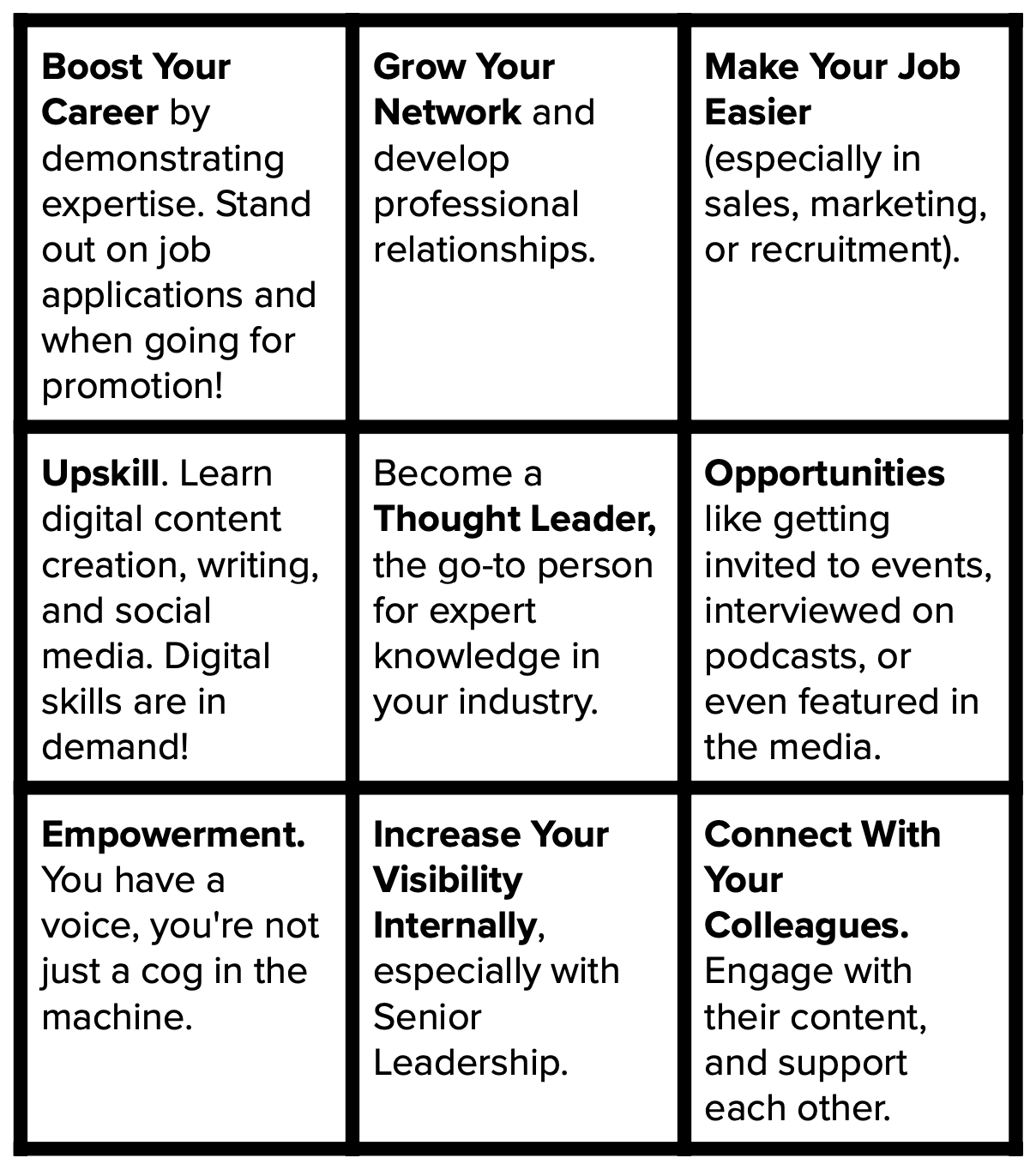
Level 2: Select Your Characters
“A company is people… employees want to know… am I being listened to or am I a cog in the wheel? People really need to feel wanted.”
RICHARD BRANSON, BRITISH BUSINESS MAGNATE, AND FOUNDER OF VIRGIN GROUP.
#26: Company Culture Is Everything. Employees That Feel Valued Will Naturally Become Advocates.
Company culture is the foundation of employee advocacy.
Employees that feel valued are much more likely to naturally advocate for your company, and want to join your program!
To put it bluntly, employee advocacy cannot exist without a good company culture. Forcing employees to post positively about your brand on social media when they don’t want to isn’t the way to go. The content simply won’t come across as authentic, and employees will begrudge you for making them do it.
A thriving company culture encourages collaboration, creativity, and an atmosphere of trust. You’ll want honest feedback on your advocacy program content in order to improve it, and you’ll only get this in an environment where employees feel safe to voice their opinions.
Focus on improving your company culture, and you’ll see better results from your program.
#29: Time is Money: Demonstrate How Advocacy Helps Salespeople Hit Sales Quotas
Onboarding your company’s salespeople is likely to be a little more complicated than onboarding other employees. You may have to take a slightly different approach.
Assuming salespeople are all about money is a rather stereotypical view. Money is unlikely to be their sole focus, but the nature of their work and professional environment means it’s likely to be an important factor in their working lives.
To a salesperson, time is money. A salesperson you invite to advocate might feel you’re asking them to give up their time for something that’s not a priority for them—so be sure to explain how they can use the program to help them hit their sales quotas.
You might, for instance, remind them that being active on social media and sharing content aimed at their target markets will mean they’re at the front of prospects’ minds when they’re ready to purchase. You might also direct them to the swathes of information assets and courses about social media’s positive impact on sales.
Make sure you align with your company’s sales leaders first, though. You’ll need to ensure they share your vision of using social media to increase sales opportunities and nurture existing pipelines before you start onboarding their employees.
Your sales team members have all the tools needed to become thought leaders. They’ll be able to share product information, industry insights, and knowledge to make potential customers believe it’s your company that has the answers they’re looking for.
Of all your company’s employees, it’s the salespeople who will benefit most from a successful employee advocacy campaign. Make sure they know that.
Remind them that being active on social media and sharing content aimed at their target markets will mean they’re at the front of prospects’ minds when they’re ready to purchase.
Read our guide to Employee Advocacy for Sales Enablement.
Level 3: A Day In The Life
#32: LinkedIn feed full of your company content? Don’t worry, you’re not overdoing it.
When you first launch an advocacy program, your social media feed might seem overwhelmed with posts from your advocates. You might feel you’ve overdone things, and that there are just too many people sharing your company’s content.
Don’t panic!
Naturally, as an employee advocacy program manager, you’ll be connected with lots of your colleagues on social media. So when they post, it’ll show up in your feed.
Also, social media algorithms are largely determined by whose content you engage with, which is likely to be your co-workers. Therefore, as advocates start to share content, the algorithms will serve you that content.
It’s important to consider that other users won’t have the same feed as you. If you want to get a more realistic view of your program’s output, make your feed view chronological.
Our research shows network overlap is typically less than 5%, so it’s not something that should worry you. Nonetheless, it’s definitely something to be aware of.
You can help combat overlap by asking your advocates to share content at different times, thus spreading out its distribution.
Remember: if your feed gives the impression that too many advocates are sharing content, it probably means your advocacy program is working well.
“Becoming well known (at least among your prospects & connections) is the most valuable element in the connection process.”
JEFFREY GITOMER, SALESPERSON AND AUTHOR OF 17 BESTSELLING BOOKS.
Aim for 1 post per day
2 is pushing it
3 is far too much!
#36: Cap It: Limit Your Employees’ Daily Shares.
You want employees to be excited about the launch of your employee advocacy program, and obviously, you want them to participate. But you do need to be wary of them being over-eager and sharing everything in sight.
New advocates may be lacking in social media experience, and if you’ve created an exciting program encouraging them to share in order to succeed, they may think that the more they share, the more successful they’ll become. So it’s always a good idea to have a content sharing limit.
If an advocate shares 10 times a day, it’s going to look bad to their audience—and that will be bad for your company and its brand. It could also negatively impact the credibility and reputation of your program, reducing the number of potential advocates.
Nobody wants to join a program that carpet-bombs social media with repetitive content.
You need advocates to be sharing quality content with their networks, in order to generate engagement. But you don’t want them sharing for the sake of sharing.
The average user of our platform shares 2.2 pieces of content a week, which is OK… but one post a day per advocate is probably the sweet spot.
Two a day is actually quite a lot, and our research shows that sharing more than three times a day actually has a negative impact on engagement.
Level 4: Killer Content
#49: Categorize & Define Your Content Sources Clearly
It can be daunting to think that you need to curate every single piece of content for your employee advocacy program before people share it. This is a common misconception. You’ll want to add content as you go, so it’s up-to-date and as fresh as it can be. This doesn’t apply to evergreen content, but we’ll get to that in tip #61.
In 99% of cases, when content is going into an employee advocacy program, it is already in the public domain. It has already been signed off and published. Before you launch your program, create a ledger of content sources—the places where you are already regularly publishing content. This could be obvious things like your company news page, blog, or YouTube channel, but it could also be third-party content sources, whether it’s Forbes magazine or trade press specific to your industry.
Once you’ve created this list of content sources, map them to the business units, whether that’s geographies, departments, or service lines. You want the right content going to the right people.
Providing relevant content to your employees is incredibly important—you want to provide value, so making sure they have access to hyper-relevant content will go a long way.
Where possible, it is worth automating the process of that content coming into your employee advocacy program. This will reduce the time it takes to source relevant content. Using RSS feeds, dedicated advocacy software, or content aggregation tools can assist with this.
3 Steps to Defining & Mapping your Content Sources:
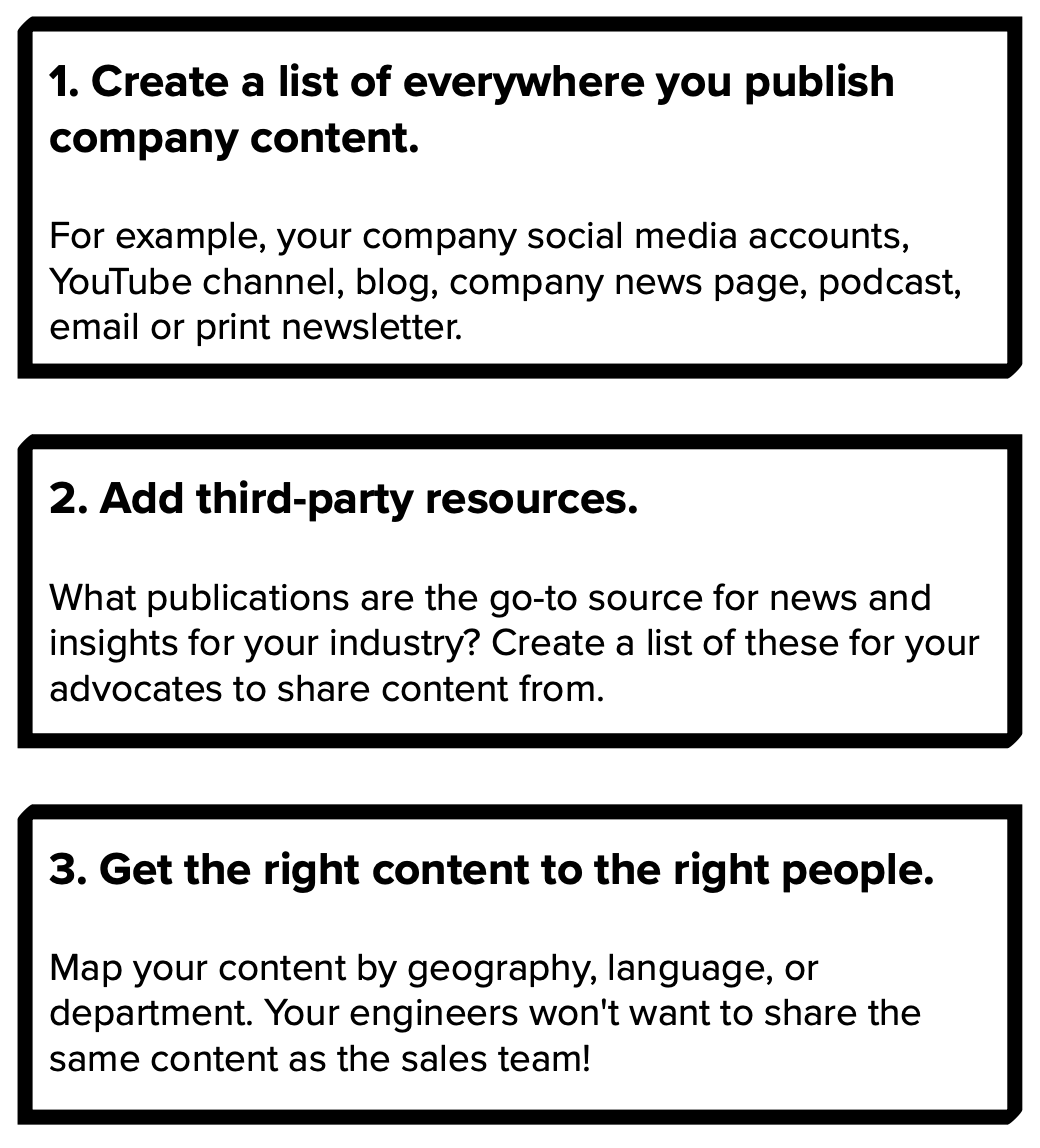
Think of each article of your program’s content as belonging to one of these three categories:
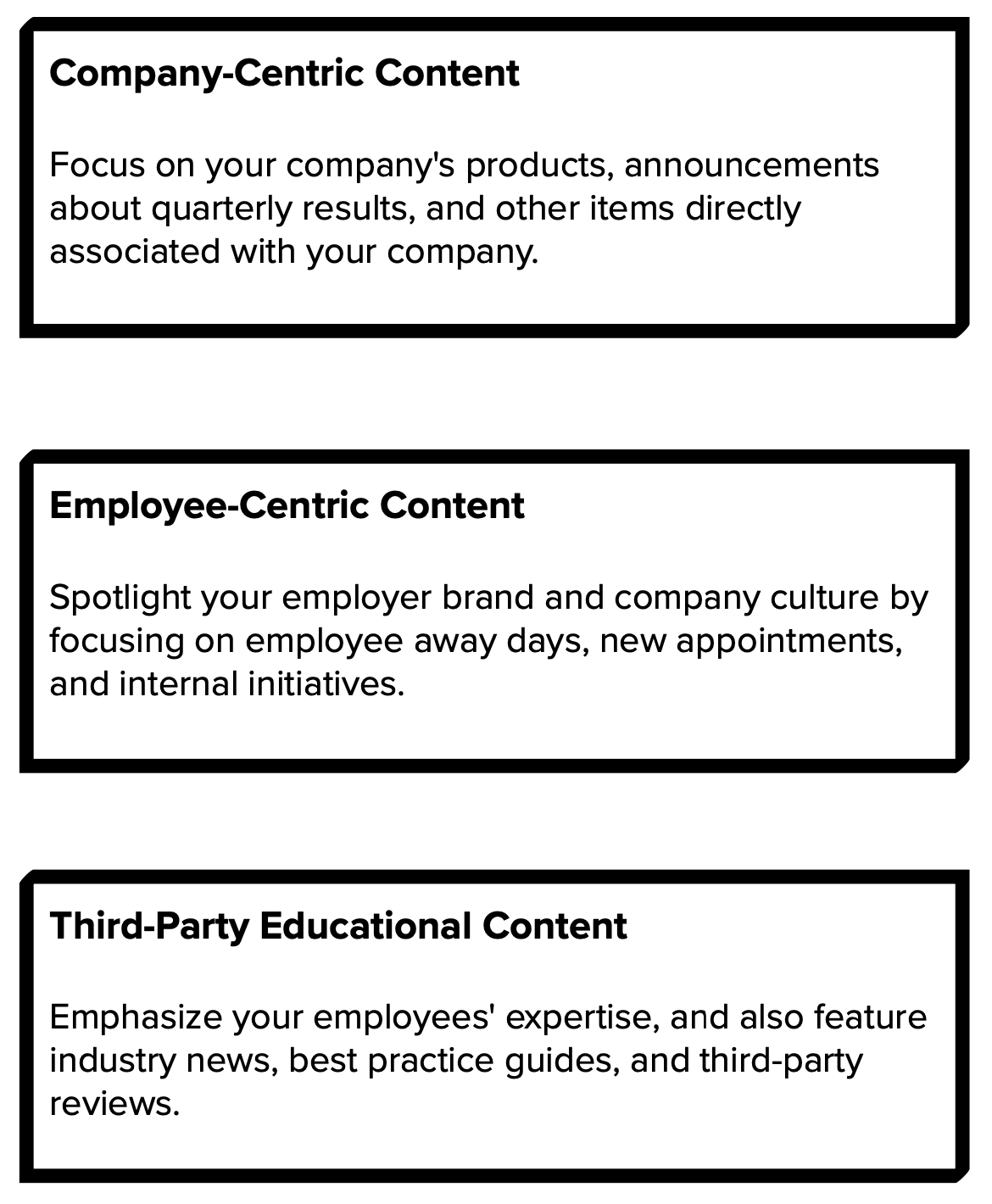
#51: It’s Not All About You: Keep Your Content Varied
Using your employee advocacy program to communicate your sales message will probably be fine, as long as it’s done well.
Creating gated content to secure contact details, so a salesperson can immediately try to win business, is probably doing it badly.
Not everybody who looks at your content will be in a buying cycle at that point. Your program’s content should reflect that, and take the opportunity to create trust for your brand by educating the market and providing insight into your company.
You might, for instance, decide to spotlight your employees by celebrating promotions, weddings, and births. Creating educational content to enhance people’s understanding of your industry and how they might do their jobs better can also be an effective tool.
That way, when those people are looking to buy, they’ll think of your company as a trusted advisor.
I recommend that your content should be one-third company-centric, one-third employee-centric, and one-third educational content from third parties.
#65: Provide Hyper-Relevant Content for Each Employee: Set Up ‘Micro-Programs’ by Department or Geography
Divide your program into micro-programs by department or geography, and appoint a team leader in charge of content curation for each one. This will not only reduce the workload for your advocacy program leader, it will also allow you to tap into department-specific or local knowledge. This makes each team’s shared content more relevant to their audience.
As your program grows, it will naturally pull in advocates from more areas of your business—and each area will have its own agenda. Swimming with this current can make it much easier to scale your program, so consider reaching out to HR and Sales teams, and any other departments that will see value in curating their own content.
You might also consider onboarding advocates purely for their willingness to create and curate content. Passionate advocates with creative flair can be great assets to your program, whether they’re micro-program leaders or not.
Delegating at least some of your program’s content creation and curation will allow your program leaders to focus on program management and policy instead—tasks that cannot be delegated. Plus, it ensures that the content provided is relevant to each employee.
4 Ways to Segment Your Micro-Programs:

Level 5: Executive Influence
Your company’s senior leaders have a vested interest in the business, so it shouldn’t be a hard sell to activate them, and doing so is a critical step to achieving a scaled-out employee advocacy program.
#75: Senior Leadership Participation = Winning
Your company’s senior leaders will naturally have more extensive and valuable social media connections than somebody who has just started in their career.
Such leaders have nurtured their careers over many years and will be connected to more prospective clients and potential hires—and perhaps even to members of the press.
Onboarding senior leaders has its challenges though, particularly when trying to drive social media usage. Many of them will be (to put it politely) ‘non-digital-natives’. They are more likely to have forgotten their LinkedIn password than to be posting daily.
Nonetheless, they are your thought leaders, so they should be active on social—talking about the company and industry news… and perhaps even employee advocacy.
Your company’s senior leaders have a vested interest in the business, so it shouldn’t be a hard sell to activate them, and doing so is a critical step to achieving a scaled-out employee advocacy program.
The simple reason for this is that employees will follow the example set by their senior leadership. So leaders are not only great advocates for sharing content, but they can also become role models for employees.
They tend to be a competitive crowd, too. Create a social media leaderboard to pit them against each other, and watch their efforts skyrocket. They will all want to be top of the leaderboard—even if it’s just for bragging rights.
Level 6: Maintaining Momentum
#80: Competition Generates Activity: Create Competitive Leaderboards
Gamification and leaderboards are not necessarily the same thing. When we think about gamification, it is more about providing rewards for activity.
Leaderboards, on the other hand, are more about friendly competition without the incentives.
Leaderboards are a very simple and effective way of creating a competitive environment. People will want to participate for the value of being seen as more effective at the task of being active on social. This is especially true when it comes to salespeople and senior leadership.
You can create a leaderboard for the entire organization, but sometimes it’s more effective to create leaderboards by department or location. This way, the people who are in the leaderboards will know the other people, driving further competition to outrank their peers.
Encouraging this competitive activity is easy. Create a champions’ leaderboard for your advocates that generate the most engagement in a week or month, and highlight who is leading the way each week. Let your advocates’ competitive nature kick in!

The reality is that the average employee doesn’t care about CPCs, CPAs, or any other marketing metric that you may care about.
Use our feedback survey template to gather useful insights from your advocates to improve your program.
#88: Want to Generate Buzz About Your Program? Share Success Stories, Not Statistics
People remember stories. They don’t remember statistics.
The reality is that the average employee doesn’t care about CPCs, CPAs, or any other marketing metric that you may care about.
You need to listen to feedback from the frontline to discover the real impact of your advocacy program. It could be a simple story of a salesperson closing a deal, or a recruiter finding their next hire.
This feedback will not only help you improve your advocacy program by tailoring it to employees’ needs, but sharing the stories will create buzz, encouraging more people to join.
Yes, it’s great to have good statistics, but it’s the stories that will win you new advocates!
Level 7: The Score Card
#92: Keep a Closer Eye on the Numbers With UTM tracking
Attribution. Attribution. Attribution.
Understanding how many people converted from employee advocacy content is essential for demonstrating ROI.
You need to understand where your website traffic is coming from, what content is performing best, and how it’s helping you reach business goals.
Advocacy tends to have a much lower bounce rate than other traffic sources, as peer-to-peer sharing is more authentic. But once they’re on your website, where are people going? Are they booking a call with your sales team? Are they opting into your email newsletter?
It’s time to get familiar with Google Analytics and UTM tracking.
A UTM code is simply a bit of code you can add to the end of a URL to track clicks. It’s an incredibly useful tool to understand exactly where your traffic is coming from, and it’ll be automatically shown within Google Analytics.
You can track 5 different parameters with UTM codes: source, medium, campaign, term, and content.
3 Ways to Use UTM Tracking for Monitoring Employee Advocacy Content Performance:
- Track how your advocates’ content performs on different social channels. Find out which platforms drive the most website clicks, and then compare advocate clicks vs. organic social and paid social clicks in Google Analytics.
- Monitor content performance from different teams, e.g. Sales, Marketing, Recruitment. Who drives the most traffic? Go deeper by creating UTM tags to identify specific users. That way you can find your top performing advocates, and see whose share led to which sale.
- Compare clicks from different content variations on the same platform. For example, compare LinkedIn clicks by content type: short-form vs. long-form video, carousel posts, or text-only posts.
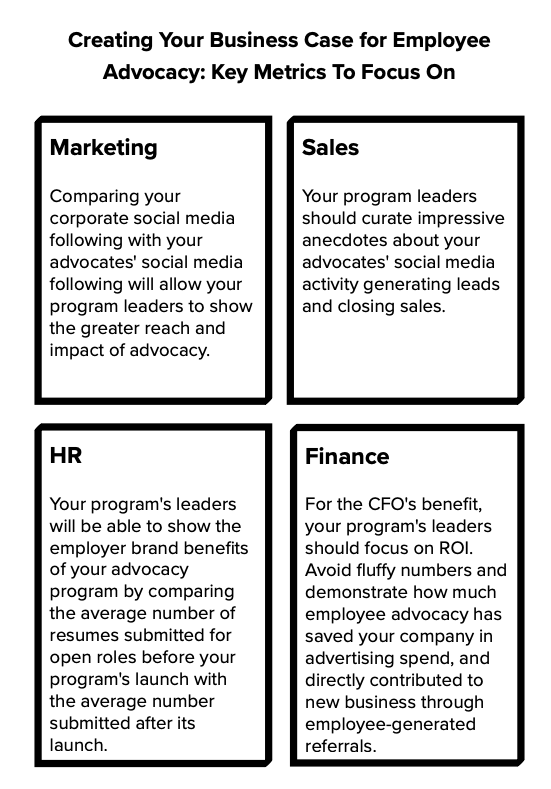
Use our ROI Calculator and Reach Calculator to discover the impact that an employee advocacy program can have for your organization.
#96: Keep Building Your Business Case… and Be Ready to Back It.
It’s quite possible that some of your company’s C-level executives won’t fully understand your employee advocacy program’s value, and so won’t be as supportive of it as they should be.
Because of that, it’ll be important for your program’s leaders to be ready and able to demonstrate its cost-effectiveness with hard numbers—especially when it comes to asking for last year’s budget to be matched.
From launch day onwards, your program leaders should invest time in building a multi-aspect business case to prove its value to your C-level Marketing, Sales, HR, and Financial executives.
Their overall goal will be to show that when it comes to building your company’s brand and connecting with both prospective and existing clients, employee advocacy is far and away the most cost-effective method.
Level 8: Career Mode
#97: Keep the Pros Close!: Network with Other Stakeholders
It’s likely there are many people in your company who will see significant value in employees sharing content. These people will have a vested interest in your program. Finding them will benefit your program immensely.
If your advocacy program is going to be large, you’ll need to involve people from other business units and geographies.
Talking to sales directors who manage large teams can be a great way to onboard vast swathes of employees. They’ll have the teams and the use cases—you’ll only need to connect the dots for them.
The same goes for HR directors and talent attraction leaders. Bringing them into the fold early will have a huge, positive impact on your employer brand and hiring.
Don’t make advocacy just another daily task. Create a community around your program—perhaps in Microsoft Teams or Slack—so advocates and department leaders can share their successes and learn from one another.
Who Are the Key Stakeholders With a Vested Interest in Employee Advocacy Success?
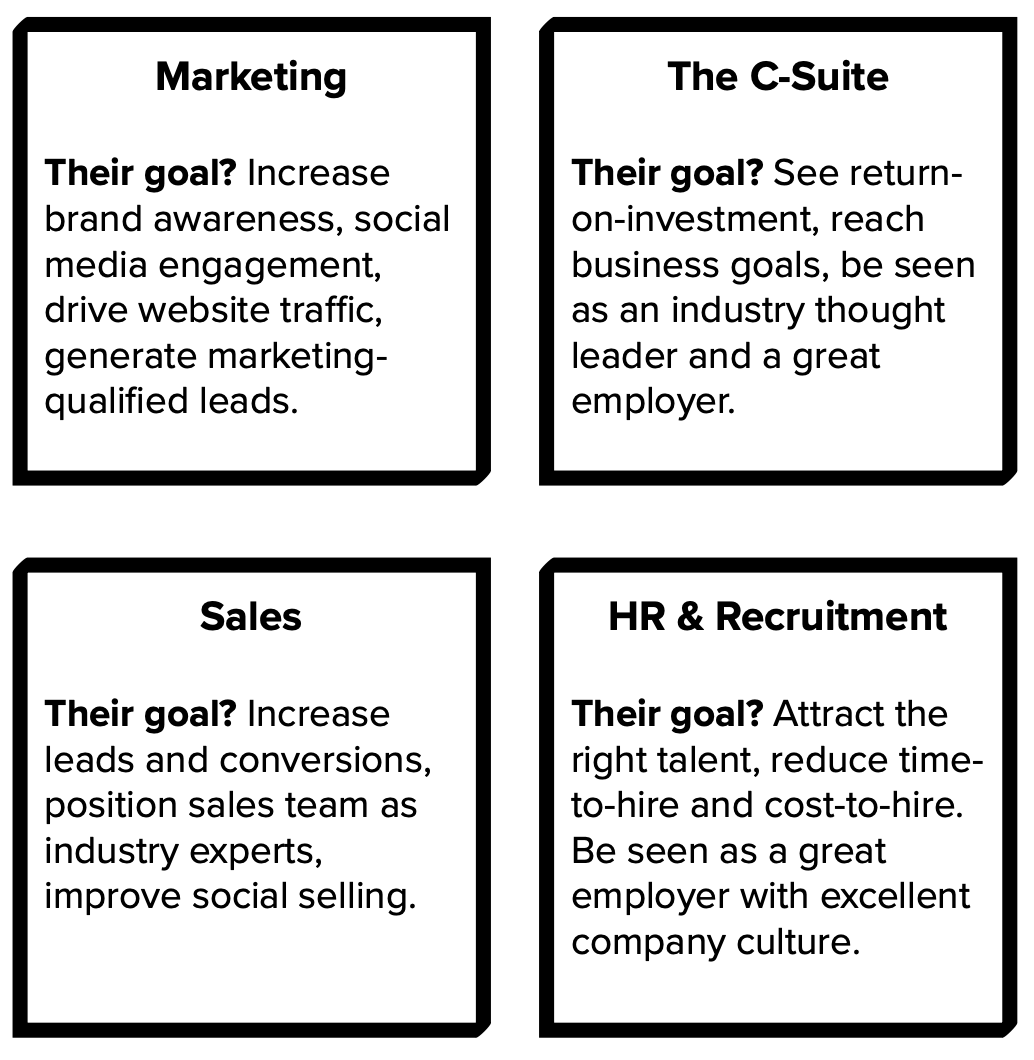
Discover More Employee Advocacy Cheat Codes
Preview more of Bradley’s book:
Employee Advocacy: 101 Cheat Codes by Bradley Keenan is available to purchase on Amazon, in paperback and Kindle formats.
If you prefer to listen, an audiobook version narrated by Bradley is available on Audible and Spotify.
We do also have a number of free copies available for those looking to improve their employee advocacy efforts.
If you want to get your hands on one, register your interest below!
Register Your Interest 👇
Ready to Take Your Social Selling Efforts to the Next Level with Employee Advocacy?
Book a demo of DSMN8, the #1 Employee Advocacy Platform.





